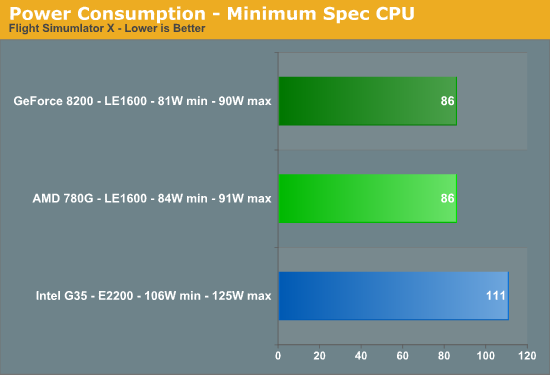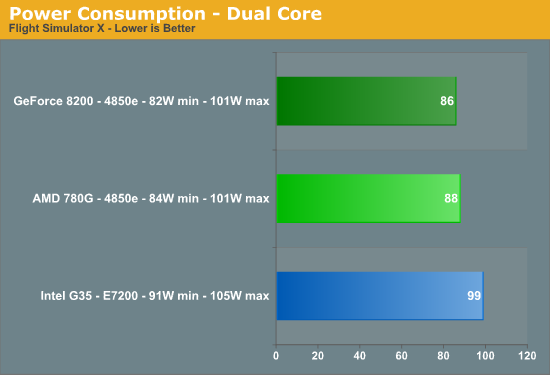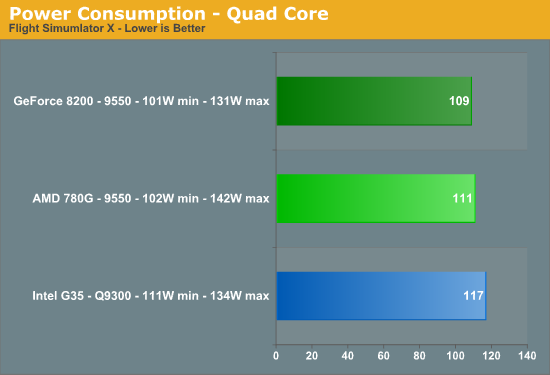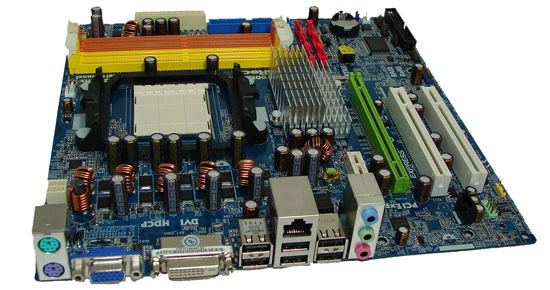IGP Power Consumption - 780G, GF8200, and G35
by Gary Key on April 18, 2008 2:00 AM EST- Posted in
- CPUs
Flight Simulator X Test
Whether playing Solitaire since the Windows 3.0 days or flying around your favorite locale in the longest running series on the PC, casual gaming on the PC is an activity just about everyone with a PC has done at one time or another. Our test today consists of a flight around the Honolulu harbor area and is something all three chipsets can handle, with the appropriate settings and resolutions. The actual winner is the 780G chipset, but what we are concerned about is how many dollars your electric company will collect when you relax and play a game.



We listed minimum and maximum voltages during our six-minute trip around the harbor, but the charts show the average. The current version of Flight Simulator X with the Acceleration Pack is fully multi-core aware and provides a workout for both the CPU and GPU as you crank up the settings. Our AMD LE1600 is a single-core CPU so the voltage variations are not as great compared to the multi-core CPUs. This processor stayed near the 100% utilization level during FSX testing, although frame rates did not seem to suffer that much at our 1024x768 medium settings.
The results are closer this time around between our two AMD platform chipsets. The GeForce 8200 once again finishes slightly in the lead but our upcoming gaming tests will show it following in the footsteps of the AMD 780G. The results are a tie between the AMD chipsets but a 25W advantage over G35 with the low-end processors, a 2W and 13W improvement with the dual cores, and a soft landing with 2W and 8W differences between the quad cores.

First Thoughts
We told you it would be a short article. However, we think the results today should provide a better indication to each platform's power requirements with a variety of CPUs likely to end up in these boards and applications that tend to stress those same processors. Unless the next NVIDIA driver set increases power consumption, then we have a surprise winner between the latest IGP chipsets from the big three. The next question we will answer is performance per watt and those results are likely to lead us down another path.
The power bill savings alone are not that large, of course. Running 24/7, 365 days per year, a 10W power difference works out to 87.6 kWh of energy over the course of a year. At a rate of 10 cents per kWh, that would work out to less than a dollar per month. In the bigger picture, however, the 5W to 25W difference between chipsets or platforms can be far more meaningful. If you want a silent - or at least very quiet - PC, every watt saved can be meaningful. Cooler running chipsets can also avoid the need for "noisy cricket" fans or monstrous cooling configurations. All other things being equal, we would definitely prefer less power-hungry components.










44 Comments
View All Comments
Johnniewalker - Friday, April 18, 2008 - link
I would also like to see what would happen if you swapped out the PSU with a lower power one such as the Seasonic S12 II 380w or 430w.If we are maxing out at 115w on the Intel G35 Quad Core, it would seem that either of those PSU's would provide more than adequate power. Would they draw less than a larger PSU or not. If they do, is the difference worth limiting yourself to a small PSU? I am not sure how limited I mean as the 430 PSU is both crossfire and sli certified.
kb9fcc - Friday, April 18, 2008 - link
I found it so surprising that the single core CPU LE-1600 should be beat out by it's multi-core sibling the 4850E, that I had to look for an explanation.The first thing I noticed, is I could find no data on the 4850E, it didn't even appear at AMD's site. However, I found data for the 4050E and 4450E at Newegg, so I'll just have to assume that the 4850E is just a faster clock speed (in future articles, could you please have more details on the processors used, especially new/unknown/unavailable units?).
They're all rated at 45w and have the same amount of cache, so that leaves that fact that the LE-1600 is built on 90nm vs. 65nm tech of the 4850E to be the only cause of this effect, though one wonders if there were other enhancements in the stepping that could be responsible too. That begs the question, what if a single core based on 65nm were used? The only I can find are the LE-1200 series, which are Semperons by definition and have less cache.
Further, regarding the results that the 8200 board used less than the 780G, I question based on not knowing anything about the Biostar TF8200 A2+ at all. Does it have exactly the same features as the Gigabyte MA78GM-S2H? I.e., are there any other chipset differences on the boards that could account for the power draw? (1394, sound, raid, etc.) Also, do other 8200 based boards return the same results? As for that thought, how do other 780G boards fare (Asus, Biostar, ECS)? Why not put the TF8200 up against its Biostar 780G sibling the TFORCE TA780G M2+? I think calling the 8200 the winner is premature without any other data points.
Final thought. Just how green can you go? By selecting the right CPU, memory, HD, PS, fans, cases, etc., what can we learn from this test that we can use to select greener components next time? Do really need a 2.5GHz 4850E, or will a 2.3GHz 4450E do as well and draw less? For that matter, just how does an LE-1250 fare? Sure it may not work out in a HTPC, but what can it do? Do we really need two optical drives, especially if the LG unit does it all? Can we use a lower wattage, high efficiency PS to good effect? Are there memory modules that are stable at 1.8v that draw fewer watts? Can only 2GB be used? What about 2x2GB instead of 4x1GB? etc., etc. etc.
cghebert - Friday, April 18, 2008 - link
Regarding the differences between 8200 and 780g. The MAJOR one, for me anyway, is that the 8200 boards will be ably to output 8 channel uncompressed sound (for HD DVD and Blu Ray) from their HDMI ports. 780g (and every other HDMI motherboard, with the exception of the Asus Intel G35 board) only puts out the equivalent of 2 channel uncompressed audio (or 5.1 compressed, i.e. AC3).This is why I (and many others over at AVS forums) have been eagerly anticipating the 8200 boards.
To me that is the most distinctive issue between these two chipsets. Beyond that, most of it just comes down to ATI vs. Nvidia video quality/driver issues.
Much more info on this discussion here:
http://www.avsforum.com/avs-vb/showthread.php?t=99...">http://www.avsforum.com/avs-vb/showthread.php?t=99...
royalcrown - Sunday, April 20, 2008 - link
You may want to wait and see about the quality issues as certain families of Nvidia chipsets were notorious for data corruption and it appears that that may be an issue with the 700 series according to a blog on here.Read all of the postcards from the edge, and maybe wait for some reviews to be safe ;)
lightzout - Saturday, April 19, 2008 - link
Wow, the HDMI output and the potential to run a cooler, quieter box may mean I will finally be able to get my HTPC box into the living room and hooked up to the HDTV. I am as green as anyone can be without going off-grid with solar but the minimal differences in wattage here aren't the only upside. I want to have a silent pc that works great. It nice to see companies headed towards efficiency but improving other areas of the home are more likely to offer a substantial reduction of power usage overall.I want a low power, stable platform for MCE2005 that will fit into my Dvine box. Right now I use an underclocked nforce2 with a geforce 6200 which barely manages the workload. Its too noisy and consumes too much power to justify running 24/7 so I miss recording some shows. I think I may have finally waited long enough to upgrade.
This was a great article and I hope Anandtech continues to follow other efforts to produce greener, quieter components for the "cooler" under-clocking crowd.
DanDeighan - Friday, April 18, 2008 - link
These CPU's ARE available. Have been since the 15th. Mostly smaller vendors (see Froogle), but also available through buy.com or Amazon.com. Newegg is trailing on this one, not available there yet.Locutus465 - Friday, April 18, 2008 - link
Seems like availability for AMD products is a little uneven these days... For instance I was going to just purchase my entire "new" rig from ZipZoomFly until I realized (thankfully I did some digging before ordering) that they don't offer any B3 Phenoms. Ended up getting the Phenom 9850be from newegg. Not sure why zipzoomfly is just sitting around with out any B3 parts.FireTech - Friday, April 18, 2008 - link
bingbong may be in Australia where AMD Australia is reported (on various user forums) as stating low sales volumes of previous 45w CPUs here do not justify importing the new 4850e etc CPUs here.Not good news if it turns out to be true...
bingbong - Friday, April 18, 2008 - link
Nice to see some good low power options with a decent intergrated graphics set. Awaiting the shoot out to see 780G or 8200 will be the best bet.I am kind of pissed that the AMD 4850e chip cannot be found.
What's the point of reviewing this from February when it seems like AMD are not going to be making the CPU available.
Come on AMD!!!
Or don't you want our money!
Martimus - Friday, April 18, 2008 - link
http://www.buy.com/prod/amd-athlon-64-x2-dual-core...">http://www.buy.com/prod/amd-athlon-64-x...mhz-ht-1...Plus many other places, but not on newegg yet.